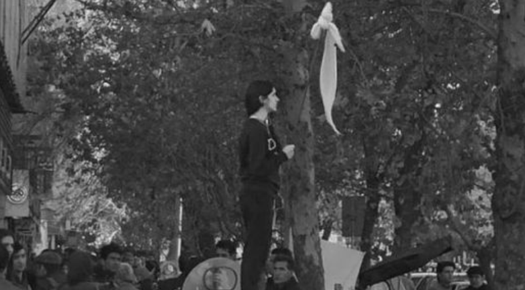
Protests in Iran began last Thursday and they were sparked by poor economic conditions. But they have quickly turned into massive demonstrations, not just against economic policy, but against the Islamist controlled government as a whole. Protests so far resulted in at least 22 deaths and more than 500 arrests.
A clip, posted to Twitter by Armin Navabi, ex-Muslim atheist and secular activist, shows a woman who took off her hijab during anti-government protests in Iran and she has been branded "a hero" for that move. The lone woman was filmed without the traditional Middle Eastern head dress and waving a white flag, in an apparent protest against the country's strict dress code for women. Armin Navabi, the founder of Atheist Republic, captioned the video: "This woman in #Iran took off her #Hijab to protest the mandatory Islamic dress code imposed on Iranian women. #IStandWithHer #IranProtests #Islam.” Many people showed support to this woman and commented that “She’s a real hero” while others called her ‘person of the year 2017’, brave and inspirational.
This woman in #Iran took off her #Hijab to protest the mandatory Islamic dress code imposed on Iranian women. #IStandWithHer #IranProtests #Islam pic.twitter.com/G6oKHIPA68
— Armin Navabi (@ArminNavabi) December 29, 2017
Someone should know at least some social norms and rules in Iran, to understand what this move means for Iranian women. Wearing of a headscarf and chador were some of the main symbols of the 1979 Iranian or Islamic revolution, along with the resurgence and wearing of other traditional Iranian dresses. Within months of the founding of the Islamic Republic of Iran, the 1967 Family Protection Law was repealed; female government workers were forced to observe Islamic dress code; beaches and sports were sex-segregated; the legal age of marriage for girls was reduced to 9 (later raised to 13); and married women were barred from attending regular schools. "Bad hijab" or exposure of any part of the body other than hands and face was subject to punishment of up to 70 lashes or 60 days imprisonment.
Tehran police announced that women will no longer risk arrest for breaching the country’s conservative interpretation of Islamic dress code, which includes a ban on wearing nail polish, heavy makeup or loose headscarves. “Those who do not observe the Islamic dress code will no longer be taken to detention centers, nor will judicial cases be filed against them,” Tehran police chief General Hossein Rahimi was quoted as saying by the reformist Sharq newspaper. The hijab is still compulsory but those caught wearing an “improper hijab” will instead be forced to take Islamic classes rather than being arrested.
Iran's young people have been calling for a change in the law regarding dress code. The problem is that hard-liners who are strongly against such moves still dominate Iran’s security forces and justice system, so it is unclear whether the change will be fully implemented. Interior Minister Abdolrahman Rahmani Fazli urged people "not to participate in these illegal gatherings as they will create problems for themselves and other citizens".
The United States warned the Iranian government that the “world is watching” in a series of statements sent out by the President, Press Secretary Sarah Huckabee Sanders, and the State Department. American president Donald Trump tweeted: “Many reports of peaceful protests by Iranian citizens fed up with regime’s corruption & its squandering of the nation’s wealth to fund terrorism abroad. Iranian govt should respect their people’s rights, including right to express themselves. The world is watching! #IranProtests”.
According to the Church Militant the woman in the video has since been arrested for taking off her hijab. Following the brave woman's arrest, people started leaving flowers on the spot where she made her now-famous stand.
Photo Credits: Twitter
